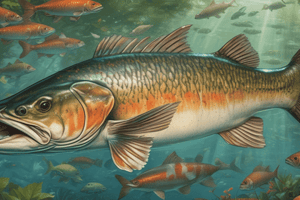Podcast
Questions and Answers
What major risk does the presence of silver carp pose to river ecosystems in the United States?
What major risk does the presence of silver carp pose to river ecosystems in the United States?
- They enhance the biodiversity of aquatic plants.
- They improve water quality by filtering pollutants.
- They outcompete native species, threatening their populations. (correct)
- They provide important food sources for native species.
Which method is most commonly used for estimating population size when counting every individual is impractical?
Which method is most commonly used for estimating population size when counting every individual is impractical?
- Surveys using satellite imagery.
- Sampling representative portions of the habitat. (correct)
- Randomly selecting individuals for a census.
- Capturing and marking organisms to monitor their movements.
What is demography in the context of ecological studies?
What is demography in the context of ecological studies?
- The observation of human impacts on ecosystems.
- A statistical study of population characteristics and changes. (correct)
- The study of biodiversity in a community.
- An analysis of resource competition between species.
How do seasonal and yearly changes in the environment affect populations?
How do seasonal and yearly changes in the environment affect populations?
Which tool was initially developed to assist insurance companies in assessing risk, but has applications in studying all living populations?
Which tool was initially developed to assist insurance companies in assessing risk, but has applications in studying all living populations?
Which of the following best describes a clumped distribution pattern in populations?
Which of the following best describes a clumped distribution pattern in populations?
What is a primary assumption of the mark and recapture method in estimating population size?
What is a primary assumption of the mark and recapture method in estimating population size?
In which scenario would you expect to observe logistic growth in a population?
In which scenario would you expect to observe logistic growth in a population?
What characterizes exponential growth in a biological context?
What characterizes exponential growth in a biological context?
Which factor does NOT typically influence the sampling method required for estimating a population's density?
Which factor does NOT typically influence the sampling method required for estimating a population's density?
Flashcards are hidden until you start studying
Study Notes
Invasive Species
- Invasive species disrupt ecological communities and threaten native species
- The silver carp is an invasive species that poses a danger to boaters and native fish populations
Population Dynamics
- Population size and composition fluctuate in response to environmental changes, disasters, and competition
- Demography, the statistical study of populations, uses mathematical tools to describe population change
- Life tables help determine life expectancy, which was initially used by life insurance companies
Population Size Estimation
- Determining population size by counting every individual can be challenging
- Scientists use various methods, including quadrat sampling and mark-recapture, to estimate population size
- The mark-recapture method estimates population size based on marked individuals recaptured in a second sample
Distribution Patterns
- Distribution patterns describe the distribution of individuals within a habitat
- Random distribution occurs when individuals are dispersed randomly
- Clumped distribution occurs when individuals are clustered together
- Uniform distribution occurs when individuals are equally spaced apart
Population growth models
- The exponential growth model describes populations that grow rapidly without limits
- The logistic growth model accounts for limited resources and carrying capacity
- Carrying capacity is the maximum population size an environment can sustain
- Intraspecific competition, competition among members of the same species for resources, intensifies when resources are limited
- Populations fluctuate around carrying capacity in a cyclical pattern
Community Ecology
- Species interactions create ecological communities
- Community diversity is the variety and relative abundance of species in a habitat
- Predator-prey relationships are a classic example of species interaction
- Predator-prey cycles involve fluctuations in population sizes
- The lynx-snowshoe hare cycle is a well-known example, with the predator population lagging behind the prey population
- Predation and predator avoidance drive evolutionary adaptations
Defense Mechanisms
- Species have evolved various defense mechanisms to avoid predation and herbivory
- Mechanical defenses include armor and thorns
- Chemical defenses involve toxic compounds
- Physical defenses include camouflage and coloration
- Warning coloration signals predators that prey is distasteful or poisonous
- Mimicry allows harmless species to avoid predation by imitating the warning coloration of harmful species
Ecological Niche
- Every species occupies a unique ecological niche, defined by its resource use and interactions with other species
- The competitive exclusion principle states that two species cannot occupy the same niche
- Competition for shared resources drives evolution and can lead to extinction
Symbiosis
- Symbiotic relationships involve close, long-term interactions between different species
- Commensalism benefits one species without harming the other
- Mutualism benefits both species
- Parasitism benefits one species while harming the other
Mutualism
- Termites and gut protists: Termites benefit from protists digesting cellulose, which they cannot do themselves. Protists benefit from a protected environment and consistent food supply.
- Lichens: Fungus and algae or cyanobacteria form a symbiotic relationship. The algae provides glucose for both organisms, while the fungus protects algae from elements and provides more accessible nutrients.
Parasitism
- Parasites benefit, while hosts are harmed.
- Hosts are weakened by parasites siphoning resources.
- Parasites may kill hosts, but often have complex reproductive cycles to allow reproduction before harming host.
- Tapeworms: Live in human intestines and consume host's food.
- Plasmodium falciparum: Protists that cause malaria, spread through mosquitoes and humans.
Communities
- Complex systems characterized by structure (population size and interactions) and dynamics (changes over time).
Biodiversity
- Species richness: The number of species in an area. Varies across the globe, with higher richness near the equator and lower near the poles.
- Island biogeography: Explains species richness on isolated islands, with relationships between species richness, island size, and distance from mainland.
Foundation Species
- Have a significant influence on community structure.
- Usually abundant organisms, often primary producers.
- Physically modify the environment to create habitats for other organisms.
- Examples: kelp, trees, coral reefs.
Keystone Species
- Have inordinate influence on ecosystem structure and biodiversity.
- Often maintain prevalence of various species.
- Examples: Pisaster ochraceus (sea star), banded tetra (fish).
Community Dynamics
- Changes in community structure and composition over time.
- Often occur due to environmental disturbances like volcanoes, earthquakes, storms, fires, and climate change.
- Equilibrium: Relatively constant number of species.
- Succession: Sequential appearance and disappearance of species after a disturbance.
Primary Succession
- Occurs on newly formed land (e.g., volcanic eruptions).
- Pioneer species: Hardy organisms that colonize new land, like lichens and certain plants.
- Over time, less hardy but more competitive species replace pioneer species.
- Leads to an equilibrium state with a different set of organisms.
Secondary Succession
- Occurs when part of an ecosystem is disturbed, but remnants of the previous community remain.
- Example: Wildfire in oak and hickory forests.
- Pioneer species quickly colonize the area, followed by intermediate species.
- Climax community: The final, stable community that emerges after succession.
Studying That Suits You
Use AI to generate personalized quizzes and flashcards to suit your learning preferences.




